Cholesterol Assay Kits
In biochemical tests, total cholesterol, HDL-cholesterol, and LDL-cholesterol in the blood are the main objects of measurement. Abnormalities in cholesterol synthesis in the liver, lipid metabolism, and nutritional status are screened by measuring cholesterol. It is also a useful indicator for assessing the risk of atherosclerosis.
Fujifilm Wako supplies separate kits for measuring total cholesterol, HDL-cholesterol, and LDL-cholesterol. With the use of microplates, these kits provide a quick and convenient method for measuring cholesterol in samples.
What is Cholesterol?
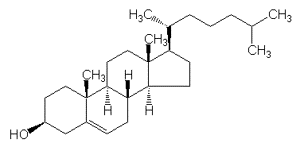
Figure 1. Structure of Cholesterol
Cholesterol is a lipid with a steroid nucleus (Figure 1). In the body, cholesterol is an essential component of cell membranes alongside phospholipids and is required for regulating membrane fluidity, among other functions. Cholesterol is also a precursor of substances like testosterone, progesterone, cortisol, and vitamin D.
Additionally, cholesterol is necessary for the synthesis of bile acids. Bile acids are digestive enzymes synthesized in the liver and are used in the digestion and absorption of lipids, such as essential fatty acids and fat-soluble vitamins. The used bile acids either return to the liver for reuse or are broken down by intestinal bacteria and excreted in the feces.
Cholesterol ingested from food is emulsified by the action of bile acids and incorporated into a lipoprotein called chylomicrons in the small intestine along with triacylglycerols. Chylomicrons enter the veins via the lymphatic system and are transported to the liver. Cholesterol in the liver is released as very low-density lipoproteins (VLDLs) along with triacylglycerols. VLDLs are transformed into low-density-lipoproteins (LDLs) in peripheral tissues and supply cholesterol to tissues and cells1). There is also a reverse pathway mediated by high-density lipoproteins (HDLs) that transports cholesterol from tissues and cells back to the liver.
While the cholesterol level in the body is maintained at a constant level due to homeostasis, an increase in lipid intake containing cholesterol or abnormalities in the regulatory mechanism can lead to an increase in blood cholesterol levels. When LDL is deposited on the walls of blood vessels and undergoes oxidation modification it can cause atherosclerosis2), which may lead to conditions such as myocardial infarction or cerebral infarction.
Methods of Cholesterol Measurement
In biochemical tests, total cholesterol, HDL-cholesterol, and LDL-cholesterol in the blood are the main objects of measurement. Abnormalities in cholesterol synthesis in the liver, lipid metabolism, and nutritional status are screened by measuring cholesterol. It is also a useful indicator for assessing the risk of atherosclerosis.
Fujifilm Wako’s LabAssay™ Cholesterol is a kit designed to determine total cholesterol using the cholesterol oxidase-DAOS method. It is intended for use with a microplate, facilitating quick and convenient measurements of total cholesterol in samples. For specific measurements of HDL-cholesterol or LDL-cholesterol, an effective method involves pretreatment with blocking polymers to protect the targeted cholesterol and eliminate the other types. Fujifilm Wako’s LabAssay™ HDL-Cholesterol and LabAssay™ LDL-Cholesterol kits include a pretreatment solution containing a blocking polymer. In addition, our kits do not require fractionation of lipoproteins by centrifugation.
Principle of the total cholesterol assay (cholesterol oxidase-DAOS method)
Cholesterol in the blood mainly exists in the forms of esterified cholesterol (cholesterol esters) and free cholesterol. When measuring total cholesterol, it is necessary to break down the cholesterol esters into free cholesterol using cholesterol esterase2).
When a chromogenic reagent is added to the sample, the cholesterol esters in the sample are broken down into free cholesterol and fatty acids due to the action of cholesterol esterase. The produced cholesterol, along with the preexisting free cholesterol, is oxidized by the action of cholesterol oxidase and produces hydrogen peroxide in the process. The resulting hydrogen peroxide induces quantitative oxidative condensation of N-ethyl-N(-2-hydroxy-3-sulfopropyl)-3,5-dimethoxyaniline sodium) (DAOS) and 4-aminoantipyrine through the action of peroxidase (POD), producing a blue dye. By measuring the absorbance of this blue color, the total cholesterol concentration in the sample can be determined.

Figure 2. Principle of the cholesterol assay using the cholesterol oxidase-DAOS method
Principle of the HDL-cholesterol assay
To specifically measure HDL cholesterol, a two-step process is required. This process involves the elimination of non-HDL-cholesterol, followed by a colorimetric reaction to detect HDL-cholesterol.
1) The first reaction(elimination of non-HDL cholesterol)
The block polymer containing hydrophilic and hydrophobic moiety in Pretreatment selectively binds to HDL in the specimens, and protects it from enzyme (CHE, CO) reactions. CHE and CO react with non-HDL lipoprotein [chylomicron (CM), very low density lipoprotein (VLDL), low density lipoprotein (LDL)]. Hydrogen peroxide produced by the enzyme reactions with non-HDL cholesterol is decomposed to water by catalase in Pretreatment reagent.
2) The second reaction(color reaction of HDL-cholesterol)
When Reacting Solution is added, the cholesterol and its derivatives in HDL produce hydrogen peroxide by CHE and CO. Hydrogen peroxide produced by the enzyme reactions with HDL-cholesterol yields a blue color pigment upon oxidative condensation with N-(3-sulfopropyl)-3-methoxy-5-methylaniline (HMMPS) and 4-aminoantipyrine in the presence of peroxidase (POD). The amount of HDL-cholesterol contained in the sample is determined by measuring the absorbance of the blue color.

Principle of the LDL-cholesterol assay
As well as HDL-cholesterol, a two-step process is required.
1) The first reaction(elimination of non-LDL cholesterol)
The block polymer containing hydrophilic and hydrophobic moiety in Pretreatment selectively binds to LDL in the specimens, and protects it from enzyme (CHE, CO) reactions. CHE and CO react with non-LDL lipoprotein [chylomicron (CM), very low density lipoprotein (VLDL), high density lipoprotein (HDL)]. Hydrogen peroxide produced by the enzyme reactions with non-LDL cholesterol is decomposed to water by catalase in Pretreatment reagent.

2) The second reaction(color reaction of LDL-cholesterol)
When Reacting Solution is added, the cholesterol and its derivatives in LDL produce hydrogen peroxide by CHE and CO. Hydrogen peroxide produced by the enzyme reactions with LDL-cholesterol yields a blue color pigment upon oxidative condensation with N-(3-sulfopropyl)-3-methoxy-5-methylaniline (HMMPS) and 4-aminoantipyrine in the presence of peroxidase (POD). The amount of LDL-cholesterol contained in the sample is determined by measuring the absorbance of the blue color.

Product Lineup
LabAssay™ Cholesterol (Total Cholesterol)
LabAssay™ Cholesterol is a kit for the determination of cholesterol in samples using the cholesterol oxidase-DAOS method. With the use of a microplate, this kit provides a quick and convenient method for measuring cholesterol in samples.
Kit Performance
| Analysis sample | Human Serum/Plasma Mouse Serum/Plasma Rat Serum/Plasma Dog Serum/Plasma Cat Serum/Plasma Culture medium (D-MEM)* |
|---|---|
| Calibration curve range | 50-592 mg/dL |
| Sample volume | 2 μL |
| Measurement duration | Approx. 10 min |
| Wavelength | Primary wavelength 600 nm Reference wavelength 700 nm |
*It is tested by using the samples that standard substances have been added to the culture medium.
Measurement availability depends on the culture medium, cell type and culture conditions. When using cell culture supernatant as a sample, please perform a spiked recovery test or dilution linearity test in advance using the culture medium to be used in your experiment.
LabAssay™ HDL-Cholesterol
LabAssay™ HDL-Cholesterol is a kit for the determination of HDL-cholesterol in samples. With the use of a microplate, this kit provides a quick and convenient method for measuring HDL-cholesterol in samples.
Kit Performance
| Analysis sample | Human Serum/Plasma Mouse Serum/Plasma Rat Serum/Plasma |
|---|---|
| Calibration curve range | 6.25-200 mg/dL |
| Sample volume | 5 μL |
| Measurement duration | Approx. 20 min |
| Wavelength | Primary wavelength 600 nm Reference wavelength 700 nm |
LabAssay™ LDL-Cholesterol
LabAssay™ LDL-Cholesterol is a kit for the determination of LDL-cholesterol in samples. With the use of a microplate, this kit provides a quick and convenient method for measuring LDL-cholesterol in samples.
Kit Performance
| Analysis sample | Human Serum/Plasma Mouse Serum/Plasma Rat Serum/Plasma |
|---|---|
| Calibration curve range | 9.38-300 mg/dL |
| Sample volume | 5 μL |
| Measurement duration | Approx. 20 min |
| Wavelength | Primary wavelength 600 nm Reference wavelength 700 nm |
| [Note] LabAssay™ series are reagents for research purposes. They cannot be used for diagnostic purposes. |
Educational Training Using LabAssay™ Cholesterol
LabAssay™ Cholesterol comes with all the necessary reagents and samples for cholesterol measurement, and can be readily used as a training kit. Students can acquire measurement skills and deepen their knowledge of the assay principle and related subjects through the measurement of control samples.
Why it is ideal for educational training
- Measurement can be completed in a short time (about 10 minutes).
- Samples can be prepared just by dissolving and mixing.
- The kit capacity is 500 assays, making it possible to conduct measurements with a large number of participants.
What can be learned with this kit
[For Beginners]
- Assay principles and procedures for cholesterol measurement
- Mastery of basic reagent preparation
- Handling of pipettors
- Handling of 96-well plates
- Handling of microplate readers
- Creating graphs and data analysis
[For Experienced Users]
- Continuous evaluation of operator skills and measurement environment
- Opportunities for identifying and improving issues related to operators and the measurement environment
(inappropriate measurement practices and procedures, and inadequate calibration of equipment) - Understanding the variations among operators and the measurement environment
- Ensuring the reliability of measurement data
- Opportunities for education and training
Kit Operation Procedures (for Educational Training)
Reagent Preparation
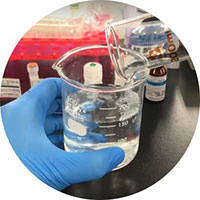
Sample Preparation
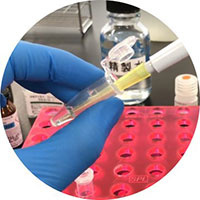
Measurement Operation
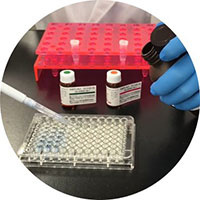
Measurement
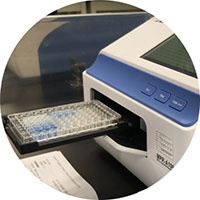
Sample Preparation (for Calibration Curve Creation)
Mix the standard solution and purified water according to the table below to prepare samples.
| Sample No. | For sample preparation | For measurement | ||
|---|---|---|---|---|
| Standard solution | Purified Water | Amount of use | Concentration | |
| 1 | 5 μL | 15 μL | 4 μL | 50 mg/dL |
| 2 | 10 μL | 10 μL | 4 μL | 100 mg/dL |
| 3 | Undiluted | - | 4 μL | 200 mg/dL |
| 4 | Undiluted | - | 8 μL | 392 mg/dL* |
*Concentration is corrected because the amount of liquid increases during measurement
Measurement
- Add each sample to the microplate according to the table 2 (2 wells for each).
- Add 200 μL of the chromogenic reagent to the wells containing the samples.
- Mix well using a shaker and allow it to stand at 37℃ for 5 minutes.
- Using a microplate reader, measure the absorbance with the blank as a control (primary wavelength 600 nm / reference wavelength 700 nm).
Table 2. Amount of sample and chromogenic reagent to be used
| Name | Sample | Chromogenic reagent |
|---|---|---|
| Unknown sample X | 4 μL | 200 μL each |
| Unknown sample Y | 4 μL | |
| Sample 1 | 4 μL | |
| Sample 2 | 4 μL | |
| Sample 3 | 4 μL | |
| Sample 4 | 8 μL | |
| Blank | 4 μL |
Data Analysis
Example of Data Recording Sheet
Record the measurement results (absorbance) on the sheet below.
Correct the data using the average value of the blank (in the case of n=2).
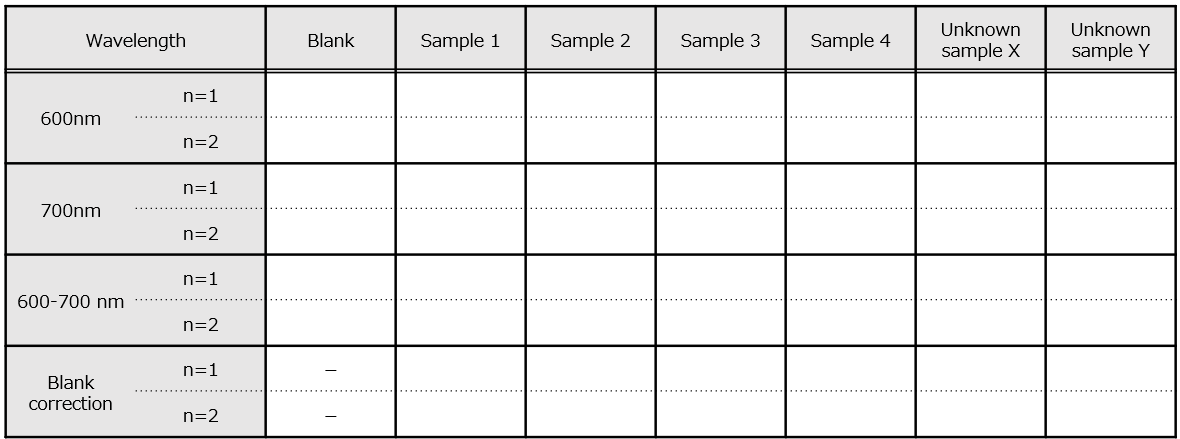
Example of data analysis
- Based on the absorbance of the blank and samples 1-4, create a calibration curve as shown in figure below.
- Calculate the cholesterol concentration of unknown samples X and Y based on the regression equation of the calibration curve.

References
- Yamada, K.: Journal of Lipid Nutrition, 14(1), 27(2005).
Cholesterol metabolism in the human body (Japanese) - Japan Atherosclerosis Society: https://www.j-athero.org/jp/general/5_colqa/ (Apr. 25th, 2023) (Japanese)
- Allain, C. C. et al.: Clin. Chem., 20(4), 470(1974).
Enzymatic determination of total serum cholesterol.
Product List
- Open All
- Close All
LabAssay™ Cholesterol
LabAssay™ HDL-Cholesterol
LabAssay™ LDL-Cholesterol
For research use or further manufacturing use only. Not for use in diagnostic procedures.
Product content may differ from the actual image due to minor specification changes etc.
If the revision of product standards and packaging standards has been made, there is a case where the actual product specifications and images are different.
The prices are list prices in Japan.Please contact your local distributor for your retail price in your region.




